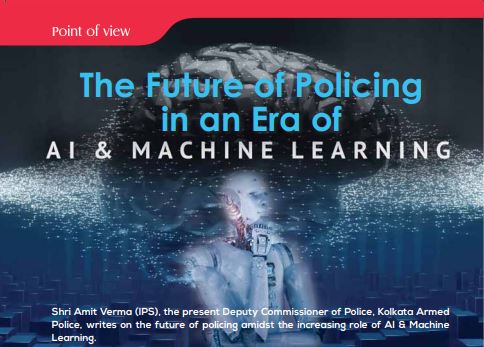Shri Amit Verma (IPS), the present Deputy Commissioner of Police, Kolkata Armed Police, writes on the future of policing amidst the increasing role of AI & Machine Learning.
“Artificial intelligence will reach human levels by around 2029. Follow that out further to, say, 2045, we will have multiplied the intelligence, the human biological machine intelligence of our civilisation a billion-fold.”
~ Ray Kurzweil (Author, computer scientist, inventor and futurist).
The 21st century is characterised by significant technological advancements which are evolving exponentially. Whether it’s Large Language Models (LLMs) or quantum computing, these developments will greatly transform every aspect of life as we know it.
Artificial Intelligence (AI) could be defined as the simulation of human intelligence in computer systems and machines. It involves the development of algorithms, software and hardware that enable computer systems to perform tasks that usually require human intelligence, such as problem-solving, learning from experience, understanding natural language, recognising patterns, and making decisions.
The AI impact is going to be phenomenal in every field, including finance, cyber security, administration, etc. AI powered by quantum computing will have capabilities beyond known limits. It will revolutionise every field, including policing.
Machine Learning (ML) focuses on developing algorithms and statistical models that enable computers to perform tasks without explicit programming. Instead of relying on explicit instructions, ML algorithms learn from data, identifying patterns and making predictions or decisions based on that information.
Law enforcement agencies are increasingly using AI to improve their ability to uphold law and order and to detect and prevent crime. AI is being used to enhance efficiency and effectiveness, ensuring a safe and secure environment for citizens.
The Utility of Artificial Intelligence and Machine Learning in Modern Policing
1) Predictive and Evidence-based Policing
AI and ML algorithms can help analyse large amounts of crime data and other related data, especially past crime records. This will not only help predict potential crime hotspots but also allocate resources and implement appropriate strategies as per the past trend and pattern analysis resulting in optimal utilisation of resources.
2) Enhanced Investigative and Crime Analysis Abilities
AI provides the capability to analyse large amounts of data, including digital evidence, to find relevant information, much like finding a needle in a haystack. This results in faster investigations and increases the probability of solving cases. AI tools can thoroughly analyse the scene of a crime (SoC) and aid in better evidence collection, ultimately leading to higher conviction rates.
3) Natural Language Processing (NLP)
This will help analyse the cyber world, especially social media posts, to detect any crime or threat and ensure that the cyber world is safe and secure for the common citizens. It will help prevent rumour-mongering and the dissemination of false narratives.
4) Cybersecurity
Quantum-powered AI systems will revolutionise the way critical infrastructure and data are safeguarded from cyber threats. This will also help ensure that any threat to cyberspace is proactively detected and neutralised, providing a safe and secure cyber ecosystem for citizens.
5) Training
Training programmes and simulations could be made realistic. VR/AR/Metaverse will help provide realistic training scenarios and impart better training to police personnel.
Issues and Concerns
1) Ethical and Privacy Concerns
If AI systems have biases, it could lead to discrimination, especially against marginalised groups. Additionally, AI and ML tools needing large amounts of data may infringe on citizens’ civil liberties and privacy.
2) Transparency and Accountability
The complexities of AI systems will make transparency and accountability challenging for their decisions and actions.
3) Public Trust
Using complex systems without public participation or engagement could lead to a trust deficit between police authorities and common citizens.
4) Algorithmic Fairness
Fairness and impartiality in AI systems are crucial to ensure effective and sustainable citizen-centric usage of these tools. They must be designed to treat all individuals equitably, regardless of race, gender, caste, colour or socioeconomic status.
Way Forward
1) Transparency and Accountability
AI systems should be transparent and accountable to public institutions. Regular third-party audits should be conducted to ensure that the systems are unbiased and free from discrimination. Officers or agencies using AI must be held accountable for any wrongful actions or decisions resulting from these systems.
2) Public Engagement and Awareness
Developing a system where common citizens provide feedback and are actively engaged in ensuring systems are citizen-centric.
3) Data Privacy
Data protection laws should be formulated to handle sensitive information of the public.
4) Comprehensive Training
Comprehensive training for police personnel on these advanced systems to make them aware of their usage, including their limitations and potential biases.
5) Oversight and Regulation Mechanisms
Establishing an independent regulatory body needs to oversee AI systems usage in policing and ensure compliance with existing guidelines and regulations.
6) Ethical Framework
Establishing an ethical framework for the usage of advanced systems is crucial to ensure their ethical soundness and consistent adherence to ethical principles in all situations.
Conclusion
The Peelian Principles (Nine Principles of Policing) were developed by Sir Robert Peel, the founder of the Metropolitan Police Service in London in the early 19th century. These principles laid the foundation for modern policing and are still very much relevant today.
The Peelian Principles
1) The basic mission for which the police exist is to prevent crime and disorder.
2) The ability of the police to perform their duties is dependent upon public approval of police actions.
3) Police must secure the willing cooperation of the public in voluntary observance of the law to secure and maintain the respect of the public.
4) The level of public cooperation decreases as the need for physical force increases.
5) Police seek and preserve public favour not by catering to public opinion but by constantly demonstrating absolute impartial service to the law.
6) Police use physical force to the extent necessary to secure observance of the law or to restore order only when the exercise of persuasion, advice, and warning is found to be insufficient.
7) The police should always maintain a relationship with the public that reflects the idea that the police are part of the public and vice versa. Police officers are simply members of the public who are paid to dedicate their full-time attention to the responsibilities that every citizen has for the well-being and survival of the community.
8) Police should always direct their action strictly towards their functions and never appear to usurp the powers of the judiciary.
9) The test of police efficiency is the absence of crime and disorder, not the visible evidence of police action in dealing with it.
Technological advancements will completely transform the policing landscape. It’s crucial to consider the Peelian Principles when developing and using these systems.
Gandhiji rightly said that the future depends on what we do in the present. Currently, lawmakers, administrators, researchers, and law enforcement agencies must collaborate and cooperate in developing a strong ethical framework. This framework is essential to ensure that technologies are used ethically, with the sole purpose of providing a safe and secure ecosystem for the citizens. l
Amit Verma, IPS
Deputy Commissioner of Police
First Battalion
Kolkata Armed Police






